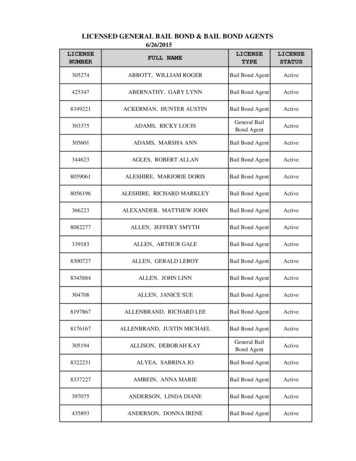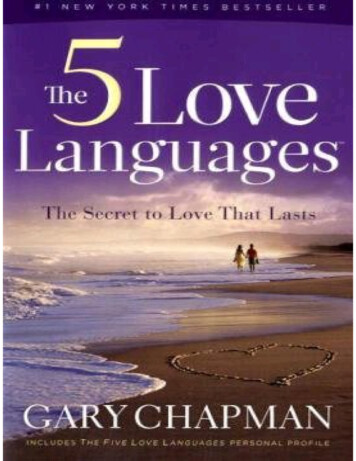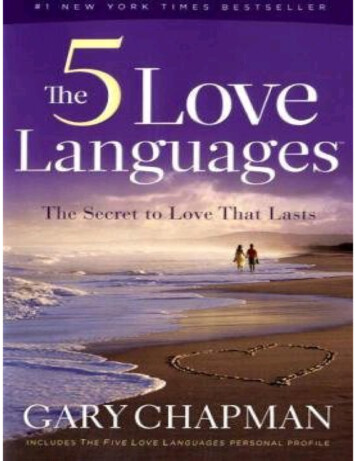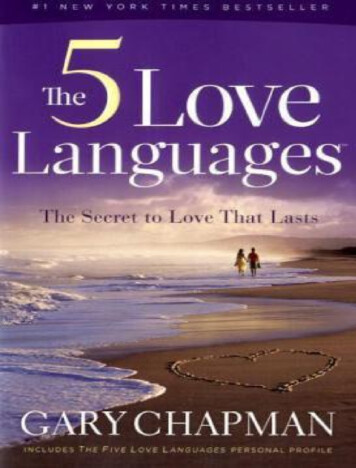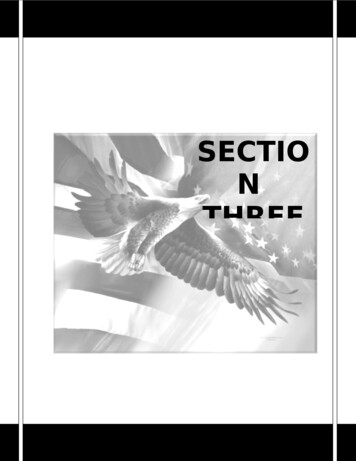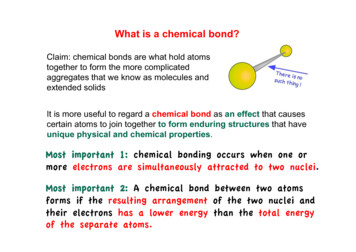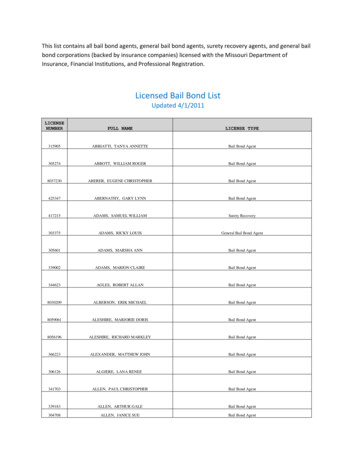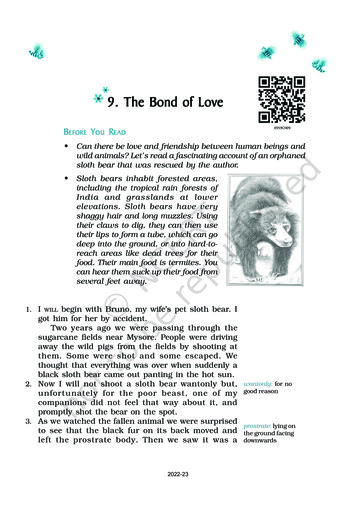
Transcription
9. The Bond of LoveBEFORE YOU READ Can there be love and friendship between human beings andwild animals? Let’s read a fascinating account of an orphanedsloth bear that was rescued by the author. Sloth bears inhabit forested areas,including the tropical rain forests ofIndia and grasslands at lowerelevations. Sloth bears have veryshaggy hair and long muzzles. Usingtheir claws to dig, they can then usetheir lips to form a tube, which can godeep into the ground, or into hard-toreach areas like dead trees for theirfood. Their main food is termites. Youcan hear them suck up their food fromseveral feet away.1. IWILL begin with Bruno, my wife’s pet sloth bear. Igot him for her by accident.Two years ago we were passing through thesugarcane fields near Mysore. People were drivingaway the wild pigs from the fields by shooting atthem. Some were shot and some escaped. Wethought that everything was over when suddenly ablack sloth bear came out panting in the hot sun.2. Now I will not shoot a sloth bear wantonly but,unfortunately for the poor beast, one of mycompanions did not feel that way about it, andpromptly shot the bear on the spot.3. As we watched the fallen animal we were surprisedto see that the black fur on its back moved andleft the prostrate body. Then we saw it was a2022-23wantonly: for nogood reasonprostrate: lying onthe ground facingdownwards
4.5.6.7.8.baby bear that had been riding on its mother’s backwhen the sudden shot had killed her. The littlecreature ran around its prostrate parent making apitiful noise.I ran up to it to attempt a capture. It scooted intothe sugarcane field. Following it with mycompanions, I was at last able to grab it by thescruff of its neck while it snapped and tried toscratch me with its long, hooked claws.We put it in one of the gunny-bags we had broughtand when I got back to Bangalore I duly presented itto my wife. She was delighted! She at once put acoloured ribbon around its neck, and after discoveringthe cub was a ‘boy’ she christened it Bruno.Bruno soon took to drinking milk from a bottle. Itwas but a step further and within a very few dayshe started eating and drinking everything else. Andeverything is the right word, for he ate porridgemade from any ingredients, vegetables, fruit, nuts,meat (especially pork), curry and rice regardless ofcondiments and chillies, bread, eggs, chocolates,sweets, pudding, ice-cream, etc., etc., etc. As fordrink: milk, tea, coffee, lime-juice, aerated water,buttermilk, beer, alcoholic liquor and, in fact,anything liquid. It all went down with relish.The bear became very attached to our two Alsatiandogs and to all the children of the tenants living inour bungalow. He was left quite free in his youngerdays and spent his time in playing, running intothe kitchen and going to sleep in our beds.One day an accident befell him. I put down poison(barium carbonate) to kill the rats and mice thathad got into my library. Bruno entered the libraryas he often did, and he ate some of the poison.Paralysis set in to the extent that he could not standon his feet. But he dragged himself on his stumpsto my wife, who called me. I guessed what hadhappened. Off I rushed in the car to the vet’sresidence. A case of poisoning! Tame Bear — bariumcarbonate — what to do?114 / Beehive2022-23scooted: ran awaycondiments: spices
9. Out came his medical books, and a feverishreference to index began: “What poison did you say,sir?” “Barium carbonate”. “Ah yes—B—Ba—BariumSalts—Ah! Barium carbonate! Symptoms —paralysis—treatment—injections of . . . Just aminute, sir. I’ll bring my syringe and the medicine.”A dash back to the car. Bruno still flounderingabout on his stumps, but clearly weakening rapidly;some vomiting, heavy breathing, with heaving flanksand gaping mouth.10. Hold him, everybody! In goes the hypodermic—Bruno squeals — 10 c.c. of the antidote enters hissystem without a drop being wasted. Ten minuteslater: condition unchanged! Another 10 c.c. injected!Ten minutes later: breathing less stertorous —Bruno can move his arms and legs a little althoughhe cannot stand yet. Thirty minutes later: Brunogets up and has a great feed! He looks at usdisdainfully, as much as to say, ‘What’s bariumcarbonate to a big black bear like me?’ Bruno isstill eating.11. Another time he found nearly one gallon of old engineoil which I had drained from the sump of theStudebaker and was keeping as a weapon againstthe inroads of termites. He promptly drank the lot.But it had no ill effects whatever.12. The months rolled on and Bruno had grown manytimes the size he was when he came. He hadequalled the Alsatians in height and had evenoutgrown them. But was just as sweet, just asmischievous, just as playful. And he was very fondof us all. Above all, he loved my wife, and she lovedhim too! She had changed his name from Bruno, toBaba, a Hindustani word signifying ‘small boy’. Andhe could do a few tricks, too. At the command, ‘Baba,wrestle’, or ‘Baba, box,’ he vigorously tackled anyonewho came forward for a rough and tumble. Givehim a stick and say ‘Baba, hold gun’, and he pointedthe stick at you. Ask him, ‘Baba, where’s baby?’and he immediately produced and cradledfloundering:struggling to movehypodermic: a longneedle used to givean injection underthe skinstertorous breathing:noisy breathing (as insnoring)Studebaker: an oldAmerican carThe Bond of Love / 1152022-23
affectionately a stump of wood which he hadcarefully concealed in his straw bed. But becauseof the tenants’ children, poor Bruno, or Baba, hadto be kept chained most of the time.13. Then my son and I advised my wife, and friendsadvised her too, to give Baba to the zoo at Mysore.He was getting too big to keep at home. After someweeks of such advice she at last consented. Hastily,and before she could change her mind, a letter waswritten to the curator of the zoo. Did he want atame bear for his collection? He replied, “Yes”. Thezoo sent a cage from Mysore in a lorry, a distanceof eighty-seven miles, and Baba was packed off.14. We all missed him greatly; but in a sense we wererelieved. My wife was inconsolable. She wept andfretted. For the first few days she would not eat athing. Then she wrote a number of letters to thecurator. How was Baba? Back came the replies,“Well, but fretting; he refuses food too.”15. After that, friends visiting Mysore were begged tomake a point of going to the zoo and seeing howBaba was getting along. They reported that he waswell but looked very thin and sad. All the keepersat the zoo said he was fretting. For three months Imanaged to restrain my wife from visiting Mysore.Then she said one day, “I must see Baba. Eitheryou take me by car; or I will go myself by bus ortrain.” So I took her by car.16. Friends had conjectured that the bear would notrecognise her. I had thought so too. But while shewas yet some yards from his cage Baba saw herand recognised her. He howled with happiness. Sheran up to him, petted him through the bars, and hestood on his head in delight.17. For the next three hours she would not leave thatcage. She gave him tea, lemonade, cakes, ice-creamand what not. Then ‘closing time’ came and we hadto leave. My wife cried bitterly; Baba cried bitterly;even the hardened curator and the keepers116 / Beehive2022-23curator: here, aperson in charge ofthe zoofretting: worried;unhappy; not relaxedconjectured: formedan opinion byguessing
felt depressed. As for me, I had reconciled myself towhat I knew was going to happen next.18. “Oh please, sir,” she asked the curator, “may I havemy Baba back”? Hesitantly, he answered, “Madam,he belongs to the zoo and is Government propertynow. I cannot give away Government property. Butif my boss, the superintendentat Bangalore agrees,certainly you may have him back.”19. There followed the return journey to Bangalore anda visit to the superintendent’s bungalow. A tearfulpleading: “Baba and I are both fretting for eachother. Will you please give him back to me?” Hewas a kind-hearted man and consented.Not only that, but he wrote to the curator tellingFor the next three hours she would notleave that cage . . .The Bond of Love / 1172022-23
him to lend us a cage for transporting the bearto Bangalore.20. Back we went to Mysore again, armed with thesuperintendent’s letter. Baba was driven into asmall cage and hoisted on top of the car; the cagewas tied securely, and a slow and careful returnjourney to Bangalore was accomplished.21. Once home, a squad of coolies were engaged forspecial work in our compound. An island was madefor Baba. It was twenty feet long and fifteen feetwide, and was surrounded by a dry pit, or moat, sixfeet wide and seven feet deep. A wooden box thatonce housed fowls was brought and put on theisland for Baba to sleep in at night. Straw was placedinside to keep him warm, and his ‘baby’, the gnarledstump, along with his ‘gun’, the piece of bamboo,both of which had been sentimentally preservedsince he had been sent away to the zoo, were putback for him to play with.22. In a few days the coolies hoisted the cage on to theisland and Baba was released. He was delighted;standing on his hindlegs, he pointed his ‘gun’ andcradled his ‘baby’. My wife spent hours sitting on achair there while he sat on her lap. He was fifteenmonths old and pretty heavy too!23. The way my wife reaches the island and leaves it isinteresting. I have tied a rope to the overhangingbranch of a mango tree with a loop at its end. Puttingone foot in the loop, she kicks off with the other, tobridge the six-foot gap that constitutes the width ofthe surrounding pit. The return journey is madethe same way. But who can say now that a slothbear has no sense of affection, no memory and noindividual characteristics?KENNETH ANDERSON118 / Beehive2022-23gnarled: rugged;twistedhoisted: raised bymeans of ropes orpulleys
I. Thinking about the TTeextI. Given in the box are some headings. Find the relevant paragraphs in the text tomatch the headings.An Orphaned Cub; Bruno’s Food-chart; An Accidental Case of Poisoning;Playful Baba; Pain of Separation; Joy of Reunion; A Request to the Zoo;An Island in the CourtyardII. Answer the following questions.1. “I got him for her by accident.”(i) Who says this?(ii) Who do ‘him’ and ‘her’ refer to?(iii) What is the incident referred to here?2. “He stood on his head in delight.”(i) Who does ‘he’ refer to?(ii) Why was he delighted?3. “We(i)(ii)(iii)all missed him greatly: but in a sense we were relieved.”Who does ‘we all’ stand for?Who did they miss?Why did they nevertheless feel relieved?III. Answer the following questions in 30 to 40 words each.1. On two occasions Bruno ate/drank something that should not be eaten/drunk. What happened to him on these occasions?2. Was Bruno a loving and playful pet? Why, then, did he have to be sent away?3. How was the problem of what to do with Bruno finally solved?Thinking about LanguageI. 1. Find these words in the lesson. They all have ie or ei in spce2. Now here are some more words. Complete them with ei or ie. Consult adictionary if here is a popular rule of spelling: ‘i’ before ‘e’ except after ‘c’. Check if this ruleis true by looking at the words above.)The Bond of Love / 1192022-23
II. Here are some words with silent letters. Learn their spelling. Your teacher willdictate these words to you. Write them down and underline the silent rhoursreturnhornetcalmcouldsignislandbuttonIII. How to look at an IndexAn index is a list of names or topics that are to be found in a book. It is a listarranged in alphabetical order at the end of a book.The following paragraph shows that the doctor is consulting the index of a medicalbook to find out which injection is appropriate for Bruno.“Out came his medical books, and a feverish reference to index began:What poison did you say, sir?” “Barium carbonate”. “Ah yes—B—Ba—Barium Salts—Ah! Barium carbonate! Symptoms—paralysis—treatment—injections of . Just a minute, sir. I’ll bring my syringe andthe medicine.”1. You have read about the French Revolution and you want to know moreabout the Third Estate in the context of the French Revolution. You canrefer to the index of the book Living World History by T. Walter Wallbank andArnold Schrier:Page no. 813Page no. 826On which pages in this book will you find information about the FrenchRevolution and the Third Estate?2. To know what ‘Food Security’ and ‘Minimum Support Price’ mean in thecontext of the economic growth of a country you can go to the subject indexgiven below from Poverty and Famines — An Essay on Entitlement andDeprivation by Amartya Sen. Under which heading in the index are youlikely to find these topics?120 / Beehive2022-23
3. Given below is a portion of an index page from the book, French’s Index ofDifferential Diagnosis, edited by F. Dudley Hart M.D., F.R.C.P.Study the entries and find out whether the following topics are discussed inthe book.(i) bronchitis due to cigarette smoking(ii) heart failure due to bronchitis(iii) bronchitis in childrenIV. 1. The Narrative PresentNotice the incomplete sentences in the following paragraphs. Here the writeris using incomplete sentences in the narration to make the incident moredramatic or immediate. Can you rewrite the paragraph in completesentences?(You can begin: The vet and I made a dash back to the car. Bruno was stillfloundering . )The Bond of Love / 1212022-23
(i) A dash back to the car. Bruno still floundering about on his stumps,but clearly weakening rapidly; some vomiting, heavy breathing, withheaving flanks and gaping mouth.Hold him, everybody! In goes the hypodermic—Bruno squeals —10 c.c. of the antidote enters his system without a drop being wasted.Ten minutes later: condition unchanged! Another 10 c.c injected! Tenminutes later: breathing less stertorous — Bruno can move his armsand legs a little although he cannot stand yet. Thirty minutes later:Bruno gets up and has a great feed! He looks at us disdainfully, asmuch as to say, ‘What’s barium carbonate to a big black bear like me?’Bruno is still eating.(ii) In the paragraphs above from the story the verbs are in the presenttense (eg. hold, goes, etc.). This gives the reader an impression ofimmediacy. The present tense is often used when we give a commentaryon a game (cricket, football, etc.), or tell a story as if it is happening now.It is, therefore, called the narrative present.You will read more about the present tense in Unit 10.2. AdverbsFind the adverbs in the passage below. ( You’ve read about adverbs in Unit 1.)We thought that everything was over when suddenly a black sloth bearcame out panting in the hot sun. Now I will not shoot a sloth-bear wantonlybut, unfortunately for the poor beast, one of my companions did not feel thatway about it, and promptly shot the bear on the spot.(i) Complete the following sentences, using a suitable adverb ending in –ly.(a) Rana does her homework(b) It rainsin Mumbai in June.(c) He does his work.(d) The dog serves his master.(ii) Choose the most suitable adverbs or adverbial phrases and completethe following sentences.get down from a moving train. (never,(a) We shouldsometimes, often)(b) I wasin need of support after my poorperformance. (badly, occasionally, sometimes)(c) Ritametwithan accident. The doctor examined. (suddenly, seriously, immediately)122 / Beehive2022-23her
3. Take down the following scrambled version of a story, that your teacher willdictate to you, with appropriate punctuation marks. Then, read the scrambledstory carefully and try to rewrite it rearranging the incidents.A grasshopper, who was very hungry, saw her and said, “When did youget the corn? I am dying of hunger.” She wanted to dry them. It was acold winter’s day, and an ant was bringing out some grains of corn fromher home. She had gathered the corn in summer.“I was singing all day,” answered the grasshopper.“If you sang all summer,” said the ant, “you can dance all winter.”“What were you doing?” asked the ant again.The grasshopper replied, “I was too busy.”“I collected it in summer,” said the ant. “What were you doing in summer?Why did you not store some corn?”Speaking‘Animals also feel the pleasure of love and the pain of separation’.Make a presentation by giving examples from your own experience.WritingPets have unique care and handling requirements and should only be kept bythose with the commitment to understand and meet their needs. Give yourargument in support of or against this statement.orThere is an on-going debate on whether snake charmers should continue intheir profession. You can get some idea about the debate from the newspaperclipping (The Hindu, 16 June 2004) given below. Read it, discuss in pairs orgroups, and write either for or against the profession of snake charmers.Report comes in support of snake charmersBy Our Staff ReporterNEW DELHI, J UNE 15. Over 30 years after the introduction of the WildlifeProtection Act (WPA) that banned the catching of snakes in India, a smallcommunity of snake charmers continues to practise the trade catching over400,000 snakes every year — which ultimately die — in defiance of the law.A report based on new research by the Wildlife Trust of India (WTI),however, has strongly recommended that the traditional knowledge of thesnake charmers and skills be now utilised for education and medicine bysetting up sapera centres. This is mainly because the community hasvirtually no access to land, education or employment opportunities. Theyare dependent on snake charming to earn a livelihood. They trade aroundThe Bond of Love / 1232022-23
as vendors of traditional medicine, snake catchers and musicians. Ignoranceabout the law is quite common.The report entitled ‘Biodiversity, Livelihoods and the Law: The Case ofthe Jogi-Nath Snake Charmers of India’ based on path-breaking researchwas formally released by the Inspector General of Forests, V.K. Bahuguna,along with a presentation by members of the sapera community in theCapital on Monday.“Despite thirty years of the law being in existence, over 70 per cent of theJogi-Naths are still dependent on snake charming to earn a livelihood.Ignorance about the law was quite common. None of them own land, eventhough they would like to,’’ said Bahar Dutt, who led this research. Notably,most of those practising the trade in the current generation are all under35 years of age.Trapping occurs throughout the year and during their travels, thoughthis activity increases during the monsoons. According to the data, eachfamily on an average collects at least seven snakes.Most snakes were force-fed and snake husbandry methods and healthwere found to be poor. “The snake charmers community council imposes aheavy fine on a person if the snake dies in his custody as it is consideredan extremely bad omen. As a result, the snakes are released when thecharmers realise that their condition is deteriorating,’’ said Dutt. Theirambition to showcase the reptiles and earn money was not fulfilled, asthey flouted four WPA provisions, for illegally possessing the animals, notfeeding them properly, causing injuries by extracting teeth unscientificallyand killing snakes for the valuable snake parts and bones. Their offencegenerally invites imprisonment for three to seven years and a fine up toRs 25,000 in each case.“On the positive side researchers found that the snake charmers possessa unique ability to handle venomous snakes with a tremendous knowledgeof the different species and their behaviour. They are also called by localfarmers to retrieve snakes, who would otherwise just kill them, fromagricultural fields or human inhabited areas,’’ she said.124 / Beehive2022-23
The SnakSnakee TTrr yingMost of us think of snakes as fearsome symbols of death.But the snake in this poem is itself a victim.The snake tryingto escape the pursuing stick,with sudden curvings of thinlong body. How beautifuland graceful are his shapes!He glides through the water awayfrom the stroke. O let him goover the waterinto the reeds to hidewithout hurt. Small and greenhe is harmless even to children.Along the sandhe lay until observedand chased away, and nowhe vanishes in the ripplesamong the green slim reeds.W.W.E. ROSSGLOSSARYreeds: water or marsh plants with thick stemsThinking about the PoemI. 1. What is the snake trying to escape from?2. Is it a harmful snake? What is its colour?3. The poet finds the snake beautiful. Find the words he uses to convey its beauty.4. What does the poet wish for the snake?5. Where was the snake before anyone saw it and chased it away? Where doesthe snake disappear?2022-23
II. 1. Find out as much as you can about different kinds of snakes (from books inthe library, or from the Internet). Are they all poisonous? Find out the namesof some poisonous snakes.2. Look for information on how to find out whether a snake is harmful.3. As you know, from the previous lesson you have just read, there are peoplein our country who have traditional knowledge about snakes, who evencatch poisonous snakes with practically bare hands. Can you find outsomething more about them?Read and EnjoyGreen SnakSnakeeEarly morning, the day before yesterday,under a slab of stone,in a crack,eyes glittering,forked tongue licking and flashing,a frog swelling his belly,he lay there quietly:a baby snake, two hands long,a green snake.“Poor thing. It’s a green snake. Still a baby.What harm can it do?” I said.My father replied,“A snake’s a snake.”And mother,“That’s where everyone walks.We don’t need trouble. Kill it.”“I can’t,” I said.Father struck him with a piece of firewood,chased him outside,and killed him flat.B.R.LAKSHMAN RAO[translated by A.K. Ramanujan]126 / Beehive2022-23
He had equalled the Alsatians in height and had even outgrown them. But was just as sweet, just as mischievous, just as playful. And he was very fond of us all. Above all, he loved my wife, and she loved him too! She had changed his name from Bruno, to Baba, a Hindustani word signifying 'small boy'. And he could do a few tricks, too.


